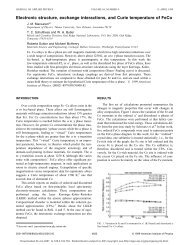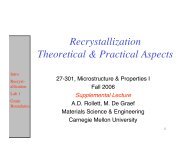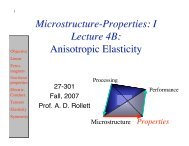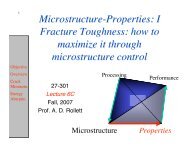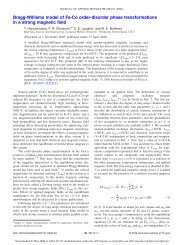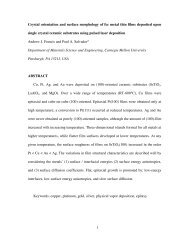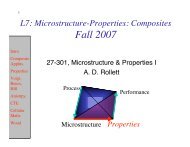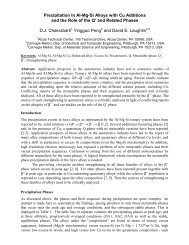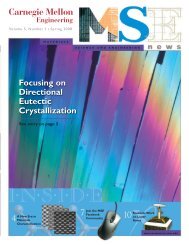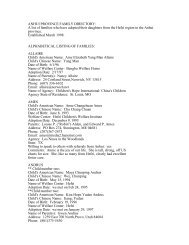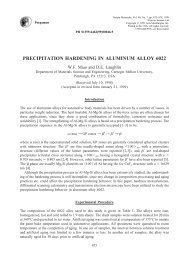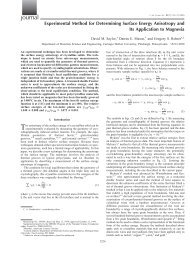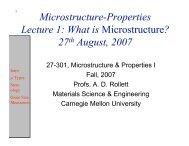The effect of Pt interlayers on the magnetic - Carnegie Mellon ...
The effect of Pt interlayers on the magnetic - Carnegie Mellon ...
The effect of Pt interlayers on the magnetic - Carnegie Mellon ...
Create successful ePaper yourself
Turn your PDF publications into a flip-book with our unique Google optimized e-Paper software.
JOURNAL OF APPLIED PHYSICS VOLUME 85, NUMBER 8 15 APRIL 1999<br />
<str<strong>on</strong>g>The</str<strong>on</strong>g> <str<strong>on</strong>g>effect</str<strong>on</strong>g> <str<strong>on</strong>g>of</str<strong>on</strong>g> <str<strong>on</strong>g>Pt</str<strong>on</strong>g> <str<strong>on</strong>g>interlayers</str<strong>on</strong>g> <strong>on</strong> <strong>the</strong> <strong>magnetic</strong> and structural properties<br />
<str<strong>on</strong>g>of</str<strong>on</strong>g> perpendicularly oriented barium ferrite media<br />
Zail<strong>on</strong>g Zhuang, a) Maithri Rao, David E. Laughlin, and Mark H. Kryder<br />
Data Storage Systems Center, <strong>Carnegie</strong> Mell<strong>on</strong> University, Pittsburgh, Pennsylvania 15213<br />
Perpendicular barium ferrite BaM films with <str<strong>on</strong>g>Pt</str<strong>on</strong>g> <str<strong>on</strong>g>interlayers</str<strong>on</strong>g> were successfully fabricated. <str<strong>on</strong>g>The</str<strong>on</strong>g><br />
<strong>magnetic</strong> and structural properties <str<strong>on</strong>g>of</str<strong>on</strong>g> BaM films were compared with BaM films without <str<strong>on</strong>g>Pt</str<strong>on</strong>g><br />
<str<strong>on</strong>g>interlayers</str<strong>on</strong>g>. It was found that perpendicular c-axis orientati<strong>on</strong> was greatly improved for films with<br />
<str<strong>on</strong>g>Pt</str<strong>on</strong>g> <str<strong>on</strong>g>interlayers</str<strong>on</strong>g>. Perpendicular remanent squareness is increased, and <strong>the</strong> c-axis dispersi<strong>on</strong> angle 50<br />
is decreased with <str<strong>on</strong>g>Pt</str<strong>on</strong>g> <str<strong>on</strong>g>interlayers</str<strong>on</strong>g> in BaM films. Also <strong>the</strong> coercivity was found to increase for films<br />
with <str<strong>on</strong>g>Pt</str<strong>on</strong>g> <str<strong>on</strong>g>interlayers</str<strong>on</strong>g>. A relative increase in perpendicular nucleati<strong>on</strong> sites over in-plane and/or random<br />
nucleati<strong>on</strong> sites c<strong>on</strong>tributes to <strong>the</strong> improvement in perpendicular c-axis orientati<strong>on</strong>. <str<strong>on</strong>g>The</str<strong>on</strong>g> increase in<br />
coercivity may be explained by a weakening <str<strong>on</strong>g>of</str<strong>on</strong>g> magnetostatic interacti<strong>on</strong>s am<strong>on</strong>g BaM grains, due<br />
to magnetostatic isolati<strong>on</strong> by <strong>the</strong> n<strong>on</strong><strong>magnetic</strong> <str<strong>on</strong>g>Pt</str<strong>on</strong>g> <str<strong>on</strong>g>interlayers</str<strong>on</strong>g> and <strong>the</strong> interdiffusi<strong>on</strong> between <str<strong>on</strong>g>Pt</str<strong>on</strong>g> layers<br />
and BaM layers during high temperature ex situ annealing. © 1999 American Institute <str<strong>on</strong>g>of</str<strong>on</strong>g> Physics.<br />
S0021-89799968608-X<br />
I. INTRODUCTION<br />
<str<strong>on</strong>g>The</str<strong>on</strong>g> c-axis perpendicularly oriented BaM thin films are<br />
promising candidates for use as a high-density perpendicular<br />
recording medium. In particular, <strong>the</strong>y are <strong>on</strong>e <str<strong>on</strong>g>of</str<strong>on</strong>g> <strong>the</strong> few<br />
perpendicular media which have a remanent squareness close<br />
to <strong>on</strong>e, which is believed to be essential for <strong>the</strong>rmal stability<br />
against demagnetizati<strong>on</strong>. Many kinds <str<strong>on</strong>g>of</str<strong>on</strong>g> underlayers, such as<br />
ZnO, 1 <strong>the</strong>rmally oxidized silic<strong>on</strong> (SiO 2), 1,2 <str<strong>on</strong>g>Pt</str<strong>on</strong>g>, 3 and AlN, 4<br />
have been used to promote perpendicular c-axis orientati<strong>on</strong><br />
in BaM films.<br />
Compared with l<strong>on</strong>gitudinal recording media, perpendicular<br />
media may be made to be relatively thick. With <strong>the</strong><br />
above underlayers, such as <str<strong>on</strong>g>Pt</str<strong>on</strong>g> and SiO 2 , <strong>the</strong> perpendicular<br />
c-axis orientati<strong>on</strong> becomes worse as <strong>the</strong> BaM film thickness<br />
increases, as shown later. To achieve better perpendicular<br />
c-axis orientati<strong>on</strong> for thicker films, <str<strong>on</strong>g>Pt</str<strong>on</strong>g> <str<strong>on</strong>g>interlayers</str<strong>on</strong>g> were added<br />
into <strong>the</strong> barium ferrite films. This article thus describes in<br />
detail <strong>the</strong> <str<strong>on</strong>g>effect</str<strong>on</strong>g>s <str<strong>on</strong>g>of</str<strong>on</strong>g> <str<strong>on</strong>g>Pt</str<strong>on</strong>g> <str<strong>on</strong>g>interlayers</str<strong>on</strong>g> <strong>on</strong> both <strong>the</strong> <strong>magnetic</strong> and<br />
<strong>the</strong> crystalline structural properties <str<strong>on</strong>g>of</str<strong>on</strong>g> BaM films. A mechanism<br />
which explains <strong>the</strong> <str<strong>on</strong>g>effect</str<strong>on</strong>g> <str<strong>on</strong>g>of</str<strong>on</strong>g> <strong>the</strong> <str<strong>on</strong>g>Pt</str<strong>on</strong>g> <str<strong>on</strong>g>interlayers</str<strong>on</strong>g> in enhancing<br />
<strong>the</strong> perpendicular anisotropy, is also described.<br />
II. EXPERIMENT<br />
BaM thin films and <str<strong>on</strong>g>Pt</str<strong>on</strong>g> films were deposited by radi<str<strong>on</strong>g>of</str<strong>on</strong>g>requency<br />
rf diode sputtering in a Leybold Z-400 sputtering<br />
system. A base pressure <str<strong>on</strong>g>of</str<strong>on</strong>g> below 110 6 Torr was<br />
achieved before depositi<strong>on</strong>. <str<strong>on</strong>g>Pt</str<strong>on</strong>g> was deposited in pure Ar gas,<br />
with a pressure <str<strong>on</strong>g>of</str<strong>on</strong>g> 5.0 mTorr and a depositi<strong>on</strong> rate <str<strong>on</strong>g>of</str<strong>on</strong>g> about<br />
100 Å/min. For all <strong>the</strong> films, a 500-Å-thick <str<strong>on</strong>g>Pt</str<strong>on</strong>g> underlayer<br />
was first deposited <strong>on</strong>to a <strong>the</strong>rmally oxidized silic<strong>on</strong><br />
(SiO 2 /Si) substrate. <str<strong>on</strong>g>The</str<strong>on</strong>g> <str<strong>on</strong>g>Pt</str<strong>on</strong>g> interlayer thickness was varied.<br />
Stoichiometric BaFe 12O 19 thin films were deposited in a mixture<br />
<str<strong>on</strong>g>of</str<strong>on</strong>g> Ar and O 2 with a total pressure <str<strong>on</strong>g>of</str<strong>on</strong>g> 5.7 mTorr and a<br />
depositi<strong>on</strong> rate about 25 Å/min. <str<strong>on</strong>g>The</str<strong>on</strong>g> flow rate ratio <str<strong>on</strong>g>of</str<strong>on</strong>g> Ar and<br />
a Electr<strong>on</strong>ic mail: zhuang@andrew.cmu.edu<br />
O 2 mixture was 67/12 sccm. All <strong>the</strong> deposited BaM films<br />
were annealed in a furnace at a temperature <str<strong>on</strong>g>of</str<strong>on</strong>g> 800 °C for<br />
about 20 min, <strong>the</strong>n gradually cooled in air.<br />
<str<strong>on</strong>g>The</str<strong>on</strong>g> <strong>magnetic</strong> properties <str<strong>on</strong>g>of</str<strong>on</strong>g> <strong>the</strong> films were studied using<br />
ei<strong>the</strong>r an alternating gradient magnetometer or a vibrating<br />
sample magnetometer VSM. <str<strong>on</strong>g>The</str<strong>on</strong>g> torque curves were measured<br />
using a torque magnetometer at a field <str<strong>on</strong>g>of</str<strong>on</strong>g> 12 000 Oe.<br />
<str<strong>on</strong>g>The</str<strong>on</strong>g> perpendicular anisotropy field H k was calculated from<br />
<strong>the</strong> peak-to-peak torque values. <str<strong>on</strong>g>The</str<strong>on</strong>g> crystalline structures <str<strong>on</strong>g>of</str<strong>on</strong>g><br />
<strong>the</strong> films were characterized by a Cu K x-ray diffractometer.<br />
A Philips EM420T transmissi<strong>on</strong> electr<strong>on</strong> microscope<br />
TEM was used to characterize <strong>the</strong> grain size and grain orientati<strong>on</strong>.<br />
III. RESULTS<br />
<str<strong>on</strong>g>The</str<strong>on</strong>g> dependence <str<strong>on</strong>g>of</str<strong>on</strong>g> remanent squareness and coercivity<br />
<strong>on</strong> BaM film thickness is shown in Fig. 1. In-plane loops<br />
were also measured to detect <strong>the</strong> in-plane oriented grains in<br />
perpendicular BaM films. Perpendicular remanent square-<br />
FIG. 1. Film thickness dependence <str<strong>on</strong>g>of</str<strong>on</strong>g> in-plane squareness S_in, perpendicular<br />
squareness S_out, in-plane coercivity H c_in, and perpendicular<br />
coercivity H c_out for single layer BaM thin films.<br />
0021-8979/99/85(8)/6142/3/$15.00 6142<br />
© 1999 American Institute <str<strong>on</strong>g>of</str<strong>on</strong>g> Physics
J. Appl. Phys., Vol. 85, No. 8, 15 April 1999 Zhuang et al.<br />
TABLE I. Structure and <strong>magnetic</strong> properties <str<strong>on</strong>g>of</str<strong>on</strong>g> BaM samples A and B.<br />
Film Film structure<br />
Squareness S<br />
perpendicular<br />
in-plane<br />
H c<br />
kOe<br />
M s<br />
emu/cc<br />
K u<br />
erg/cc<br />
(10 6 )<br />
BaM 900 Å/<br />
A <str<strong>on</strong>g>Pt</str<strong>on</strong>g> 500 Å/ 0.8 0.22 1.5 200 1.3<br />
SiO 2 /Si<br />
BaM 300/<str<strong>on</strong>g>Pt</str<strong>on</strong>g><br />
B 150) 3/<str<strong>on</strong>g>Pt</str<strong>on</strong>g> 350 0.95 0.11 2.5 220 1.7<br />
Å/SiO 2 /Si<br />
ness decreases gradually from about 0.9 to about 0.7 with an<br />
increase in film thickness from 300 to 2000 Å, while in-plane<br />
remanent squareness increases gradually from 0.18 to 0.27.<br />
Perpendicular coercivity was found to decrease with increasing<br />
film thickness from 2.3 to 1.3 kOe, and in-plane coercivity<br />
was found to increase from 1.2 to 1.8 kOe. Perpendicular<br />
magnetocrystalline anisotropy c<strong>on</strong>stant K u and anisotropy<br />
field H k were also calculated based <strong>on</strong> <strong>the</strong> torque measurements.<br />
As BaM film thickness increases from 300 to 600 Å<br />
or larger, K u decreases from 1.710 6 to 1.310 6 erg/cc,<br />
with H k decreasing from 18.2 to 12.9 kOe. <str<strong>on</strong>g>The</str<strong>on</strong>g> above results<br />
suggest a deteriorati<strong>on</strong> <str<strong>on</strong>g>of</str<strong>on</strong>g> perpendicular c-axis orientati<strong>on</strong><br />
and a decrease <str<strong>on</strong>g>of</str<strong>on</strong>g> perpendicular coercivity with an increase<br />
in BaM film thickness, which is undesirable for perpendicular<br />
recording media.<br />
To improve <strong>the</strong> perpendicular orientati<strong>on</strong> for BaM films,<br />
<str<strong>on</strong>g>Pt</str<strong>on</strong>g> <str<strong>on</strong>g>interlayers</str<strong>on</strong>g> were added between BaM films, and compared<br />
with BaM films without <str<strong>on</strong>g>Pt</str<strong>on</strong>g> <str<strong>on</strong>g>interlayers</str<strong>on</strong>g>. Two BaM samples A<br />
and B were fabricated. <str<strong>on</strong>g>The</str<strong>on</strong>g> total BaM film thickness is 900<br />
Å for both samples A and B, while sample B has two 150-<br />
Å-thick <str<strong>on</strong>g>interlayers</str<strong>on</strong>g>. <str<strong>on</strong>g>The</str<strong>on</strong>g> structure <str<strong>on</strong>g>of</str<strong>on</strong>g> samples A and B and<br />
<strong>the</strong>ir <strong>magnetic</strong> properties are summarized in Table I. <str<strong>on</strong>g>The</str<strong>on</strong>g><br />
in-plane and perpendicular MH loops for both samples A and<br />
B are shown in Fig. 2. With <str<strong>on</strong>g>Pt</str<strong>on</strong>g> <str<strong>on</strong>g>interlayers</str<strong>on</strong>g>, perpendicular<br />
remanent squareness increases from a value <str<strong>on</strong>g>of</str<strong>on</strong>g> 0.8 to 0.95,<br />
while in-plane remanent squareness decreases from a value<br />
<str<strong>on</strong>g>of</str<strong>on</strong>g> 0.22 to 0.11. <str<strong>on</strong>g>The</str<strong>on</strong>g> perpendicular magnetocrystalline anisotropy<br />
c<strong>on</strong>stant K u also increases from 1.310 6 to 1.710 6<br />
erg/cc. <str<strong>on</strong>g>The</str<strong>on</strong>g> above results indicate a better perpendicular<br />
c-axis orientati<strong>on</strong> for sample B. <str<strong>on</strong>g>The</str<strong>on</strong>g> saturati<strong>on</strong> magnetizati<strong>on</strong><br />
(M s) <str<strong>on</strong>g>of</str<strong>on</strong>g> both samples A and B is about <strong>the</strong> same, 200 and<br />
FIG. 2. In-plane and perpendicular MH loops for a sample A and b<br />
sample B.<br />
FIG. 3. <str<strong>on</strong>g>Pt</str<strong>on</strong>g> interlayer thickness dependence <str<strong>on</strong>g>of</str<strong>on</strong>g> S_in, S_out, H c_in,<br />
H c_out. <str<strong>on</strong>g>The</str<strong>on</strong>g> structures <str<strong>on</strong>g>of</str<strong>on</strong>g> all BaM films are <strong>the</strong> same as sample B except<br />
for <strong>the</strong> variati<strong>on</strong> in <str<strong>on</strong>g>Pt</str<strong>on</strong>g> thickness as noted.<br />
220 emu/cc, respectively. In additi<strong>on</strong>, sample B has a coercivity<br />
<str<strong>on</strong>g>of</str<strong>on</strong>g> 2500 Oe, while sample A has a coercivity <str<strong>on</strong>g>of</str<strong>on</strong>g> <strong>on</strong>ly<br />
1500 Oe.<br />
<str<strong>on</strong>g>The</str<strong>on</strong>g> <str<strong>on</strong>g>effect</str<strong>on</strong>g> <str<strong>on</strong>g>of</str<strong>on</strong>g> <str<strong>on</strong>g>Pt</str<strong>on</strong>g> interlayer thickness <strong>on</strong> <strong>magnetic</strong> properties<br />
<str<strong>on</strong>g>of</str<strong>on</strong>g> BaM films is shown in Fig. 3. <str<strong>on</strong>g>The</str<strong>on</strong>g> structure <str<strong>on</strong>g>of</str<strong>on</strong>g> all<br />
samples is <strong>the</strong> same as that <str<strong>on</strong>g>of</str<strong>on</strong>g> sample B. <str<strong>on</strong>g>The</str<strong>on</strong>g> <str<strong>on</strong>g>Pt</str<strong>on</strong>g> interlayer<br />
thickness ranges from 0 to 300 Å. <str<strong>on</strong>g>The</str<strong>on</strong>g> perpendicular squareness<br />
is above 0.9 for all films with <str<strong>on</strong>g>interlayers</str<strong>on</strong>g>. <str<strong>on</strong>g>The</str<strong>on</strong>g> coercivity<br />
is greater than 2 kOe for films with <str<strong>on</strong>g>interlayers</str<strong>on</strong>g>, compared<br />
with a coercivity <str<strong>on</strong>g>of</str<strong>on</strong>g> 1500 Oe for films without <str<strong>on</strong>g>interlayers</str<strong>on</strong>g>.<br />
Two <str<strong>on</strong>g>Pt</str<strong>on</strong>g> <str<strong>on</strong>g>interlayers</str<strong>on</strong>g> <str<strong>on</strong>g>of</str<strong>on</strong>g> 100 Å are enough to produce perpendicular<br />
remanent squareness above 0.9.<br />
M curves were also measured for samples A and B and<br />
are shown in Fig. 4. <str<strong>on</strong>g>The</str<strong>on</strong>g>re are <strong>on</strong>ly negative peaks for<br />
barium ferrite films A and B, which indicates str<strong>on</strong>g magnetostatic<br />
interacti<strong>on</strong>s am<strong>on</strong>g BaM grains in <strong>the</strong> perpendicular<br />
directi<strong>on</strong> for both films. Compared with sample A, <strong>the</strong> negative<br />
M peak is 1/3 smaller for sample B, which indicates<br />
weaker magnetostatic interacti<strong>on</strong>s for sample B.<br />
Similar x-ray diffracti<strong>on</strong> XRD results were obtained<br />
for samples A and B. Only 006, 008, and 0014 peaks,<br />
which indicate that <strong>the</strong> c axis is perpendicularly oriented, are<br />
observable. Rocking curves were also measured. <str<strong>on</strong>g>The</str<strong>on</strong>g> c-axis<br />
dispersi<strong>on</strong> angle 50 was measured as <strong>the</strong> full-width at halfmaximum<br />
<str<strong>on</strong>g>of</str<strong>on</strong>g> <strong>the</strong> rocking curve at <strong>the</strong> XRD peak 008 for<br />
FIG. 4. M curves for samples A and B measured by VSM.<br />
6143
6144 J. Appl. Phys., Vol. 85, No. 8, 15 April 1999 Zhuang et al.<br />
FIG. 5. TEM plan-view BF micrographs and microdiffracti<strong>on</strong> patterns for<br />
a sample A and b sample B.<br />
BaM films. It was found that 50 for samples A and B is<br />
about 8° and 6°, respectively. Sample B has a better perpendicular<br />
c-axis texture, which agrees with <strong>the</strong> <strong>magnetic</strong> property<br />
measurements.<br />
TEM plan-view bright field BF micrographs and microdiffracti<strong>on</strong><br />
patterns <str<strong>on</strong>g>of</str<strong>on</strong>g> samples A and B are shown in Fig.<br />
5. For sample A, some acicular grains are clearly seen in<br />
additi<strong>on</strong> to platelet-like grains, as shown in Fig. 5a. However,<br />
for sample B, hexag<strong>on</strong>al platelet-like grains are observed<br />
with acicular grains rarely seen, as shown in Fig. 5b.<br />
<str<strong>on</strong>g>The</str<strong>on</strong>g> acicular grains are ei<strong>the</strong>r c-axis in-plane oriented or randomly<br />
oriented. <str<strong>on</strong>g>The</str<strong>on</strong>g> electr<strong>on</strong> diffracti<strong>on</strong> from <strong>on</strong>e acicular<br />
grain shown <strong>on</strong> <strong>the</strong> left-top corner <str<strong>on</strong>g>of</str<strong>on</strong>g> Fig. 5a clearly shows<br />
c-axis in-plane orientati<strong>on</strong>. <str<strong>on</strong>g>The</str<strong>on</strong>g> platelet-like grains are c-axis<br />
perpendicularly oriented, as c<strong>on</strong>firmed by <strong>the</strong> electr<strong>on</strong> diffracti<strong>on</strong><br />
pattern from <strong>on</strong>e platelet-like grains <strong>on</strong> <strong>the</strong> left-top<br />
corner <str<strong>on</strong>g>of</str<strong>on</strong>g> Fig. 5b. <str<strong>on</strong>g>The</str<strong>on</strong>g> above results clearly indicate that <strong>the</strong><br />
<str<strong>on</strong>g>Pt</str<strong>on</strong>g> <str<strong>on</strong>g>interlayers</str<strong>on</strong>g> enhance <strong>the</strong> growth <str<strong>on</strong>g>of</str<strong>on</strong>g> <strong>the</strong> perpendicularly oriented<br />
platelet-like grains and suppress <strong>the</strong> growth <str<strong>on</strong>g>of</str<strong>on</strong>g> <strong>the</strong> inplane<br />
and randomly oriented acicular grains.<br />
IV. DISCUSSION AND CONCLUSION<br />
<str<strong>on</strong>g>Pt</str<strong>on</strong>g> <str<strong>on</strong>g>interlayers</str<strong>on</strong>g> play an important role in improving <strong>the</strong><br />
<strong>magnetic</strong> properties and crystallographic characteristics <str<strong>on</strong>g>of</str<strong>on</strong>g><br />
BaM films. Without <str<strong>on</strong>g>Pt</str<strong>on</strong>g> <str<strong>on</strong>g>interlayers</str<strong>on</strong>g>, a gradual deteriorati<strong>on</strong> <str<strong>on</strong>g>of</str<strong>on</strong>g><br />
<strong>the</strong> perpendicular c-axis orientati<strong>on</strong> with an increase <str<strong>on</strong>g>of</str<strong>on</strong>g> BaM<br />
film thickness was observed; while with two <str<strong>on</strong>g>Pt</str<strong>on</strong>g> <str<strong>on</strong>g>interlayers</str<strong>on</strong>g>, a<br />
perpendicular remanent squareness <str<strong>on</strong>g>of</str<strong>on</strong>g> 0.95 can still be<br />
achieved for a 900-Å-thick BaM film. By adjusting <strong>the</strong> number<br />
<str<strong>on</strong>g>of</str<strong>on</strong>g> <str<strong>on</strong>g>Pt</str<strong>on</strong>g> <str<strong>on</strong>g>interlayers</str<strong>on</strong>g>, <strong>the</strong> higher perpendicular remanent<br />
squareness can be maintained with increasing BaM film<br />
thickness. From TEM measurements, it is clear that <strong>the</strong> enhancement<br />
in perpendicular c-axis orientati<strong>on</strong> for films with<br />
<str<strong>on</strong>g>Pt</str<strong>on</strong>g> <str<strong>on</strong>g>interlayers</str<strong>on</strong>g> is related to <strong>the</strong> suppressi<strong>on</strong> <str<strong>on</strong>g>of</str<strong>on</strong>g> <strong>the</strong> growth <str<strong>on</strong>g>of</str<strong>on</strong>g><br />
in-plane and/or randomly oriented acicular grains.<br />
<str<strong>on</strong>g>The</str<strong>on</strong>g> mechanism for improving <strong>the</strong> perpendicular c-axis<br />
orientati<strong>on</strong> with <str<strong>on</strong>g>Pt</str<strong>on</strong>g> <str<strong>on</strong>g>interlayers</str<strong>on</strong>g> is believed to be a relative<br />
increase in <strong>the</strong> nucleati<strong>on</strong> sites for perpendicularly oriented<br />
grains over <strong>the</strong> nucleati<strong>on</strong> sites for in-plane and/or randomly<br />
oriented grains. <str<strong>on</strong>g>The</str<strong>on</strong>g> as-deposited BaM film is still amor-<br />
phous before ex situ annealing. It is believed that <strong>the</strong>re are<br />
two kinds <str<strong>on</strong>g>of</str<strong>on</strong>g> nucleati<strong>on</strong> sites for crystallizati<strong>on</strong> <str<strong>on</strong>g>of</str<strong>on</strong>g> BaM during<br />
ex situ annealing. One kind <str<strong>on</strong>g>of</str<strong>on</strong>g> nucleati<strong>on</strong> site is at <strong>the</strong><br />
interfaces formed between BaM layers and <str<strong>on</strong>g>Pt</str<strong>on</strong>g> layers. It was<br />
reported that <strong>the</strong> as-deposited BaM films are not completely<br />
disordered, but ra<strong>the</strong>r have an ordered local structure around<br />
Fe atoms, and <strong>the</strong> directi<strong>on</strong> <str<strong>on</strong>g>of</str<strong>on</strong>g> order determines <strong>the</strong> crystallizati<strong>on</strong><br />
directi<strong>on</strong> during annealing. 5 So a local order <str<strong>on</strong>g>of</str<strong>on</strong>g> BaM<br />
atoms may be arranged at <strong>the</strong> <str<strong>on</strong>g>Pt</str<strong>on</strong>g> layer interface, which is<br />
favorable to crystallize perpendicularly oriented BaM films.<br />
Thus <str<strong>on</strong>g>Pt</str<strong>on</strong>g> and BaM interfaces are believed to form nucleati<strong>on</strong><br />
sites which favor perpendicularly oriented grains. 6 In additi<strong>on</strong>,<br />
it is also believed that <strong>the</strong>re are some randomly oriented<br />
nucleati<strong>on</strong> sites in <strong>the</strong> bulk <str<strong>on</strong>g>of</str<strong>on</strong>g> BaM films. <str<strong>on</strong>g>The</str<strong>on</strong>g> total number<br />
<str<strong>on</strong>g>of</str<strong>on</strong>g> random nucleati<strong>on</strong> sites increases as <strong>the</strong> film thickness<br />
increases. While perpendicular nucleati<strong>on</strong> sites dominate<br />
random nucleati<strong>on</strong> sites for very thin films, <strong>the</strong> <str<strong>on</strong>g>effect</str<strong>on</strong>g> <str<strong>on</strong>g>of</str<strong>on</strong>g> random<br />
nucleati<strong>on</strong> sites will become larger with an increase in<br />
film thickness. So a deteriorati<strong>on</strong> <str<strong>on</strong>g>of</str<strong>on</strong>g> perpendicular orientati<strong>on</strong><br />
with an increase in film thickness is believed to be<br />
caused by <strong>the</strong> relative increase in random nucleati<strong>on</strong> sites. <str<strong>on</strong>g>Pt</str<strong>on</strong>g><br />
<str<strong>on</strong>g>interlayers</str<strong>on</strong>g> in BaM films have <strong>the</strong> <str<strong>on</strong>g>effect</str<strong>on</strong>g> <str<strong>on</strong>g>of</str<strong>on</strong>g> increasing <strong>the</strong><br />
number <str<strong>on</strong>g>of</str<strong>on</strong>g> interfaces. By adding <str<strong>on</strong>g>Pt</str<strong>on</strong>g> <str<strong>on</strong>g>interlayers</str<strong>on</strong>g>, perpendicular<br />
nucleati<strong>on</strong> sites at <strong>the</strong> interfaces increase. So perpendicularly<br />
oriented platelet-like grains are grown during ex situ annealing<br />
<str<strong>on</strong>g>of</str<strong>on</strong>g> films with <str<strong>on</strong>g>Pt</str<strong>on</strong>g> <str<strong>on</strong>g>interlayers</str<strong>on</strong>g>. Thus <str<strong>on</strong>g>Pt</str<strong>on</strong>g> <str<strong>on</strong>g>interlayers</str<strong>on</strong>g> <str<strong>on</strong>g>effect</str<strong>on</strong>g>ively<br />
improve <strong>the</strong> perpendicular c-axis orientati<strong>on</strong>.<br />
With <str<strong>on</strong>g>Pt</str<strong>on</strong>g> <str<strong>on</strong>g>interlayers</str<strong>on</strong>g>, <strong>the</strong> coercivity was found to increase<br />
from 1500 to 2500 Oe. At <strong>the</strong> same time, a decrease in <strong>the</strong><br />
M values was observed. <str<strong>on</strong>g>The</str<strong>on</strong>g> smaller M value suggests a<br />
weaker magnetostatic interacti<strong>on</strong> am<strong>on</strong>g BaM grains. <str<strong>on</strong>g>The</str<strong>on</strong>g><br />
drop <str<strong>on</strong>g>of</str<strong>on</strong>g> <strong>the</strong> M value may be related to <strong>the</strong> magnetostatic<br />
isolati<strong>on</strong> <str<strong>on</strong>g>of</str<strong>on</strong>g> BaM films by n<strong>on</strong><strong>magnetic</strong> <str<strong>on</strong>g>Pt</str<strong>on</strong>g> <str<strong>on</strong>g>interlayers</str<strong>on</strong>g> and <strong>the</strong><br />
interdiffusi<strong>on</strong> between <str<strong>on</strong>g>Pt</str<strong>on</strong>g> layers and BaM layers during annealing,<br />
all <str<strong>on</strong>g>of</str<strong>on</strong>g> which have <strong>the</strong> <str<strong>on</strong>g>effect</str<strong>on</strong>g> <str<strong>on</strong>g>of</str<strong>on</strong>g> decreasing magnetostatic<br />
interacti<strong>on</strong>s am<strong>on</strong>g BaM grains. So <strong>the</strong> decrease in<br />
magnetostatic interacti<strong>on</strong>s may cause <strong>the</strong> increase <str<strong>on</strong>g>of</str<strong>on</strong>g> coercivity<br />
for BaM films with <str<strong>on</strong>g>Pt</str<strong>on</strong>g> <str<strong>on</strong>g>interlayers</str<strong>on</strong>g>. 7<br />
In c<strong>on</strong>clusi<strong>on</strong>, BaM films with <str<strong>on</strong>g>Pt</str<strong>on</strong>g> <str<strong>on</strong>g>interlayers</str<strong>on</strong>g> were successfully<br />
fabricated and characterized. BaM films with <str<strong>on</strong>g>Pt</str<strong>on</strong>g><br />
<str<strong>on</strong>g>interlayers</str<strong>on</strong>g> have a significantly improved perpendicular<br />
c-axis crystalline texture and a larger coercivity compared to<br />
films without <str<strong>on</strong>g>Pt</str<strong>on</strong>g> <str<strong>on</strong>g>interlayers</str<strong>on</strong>g>.<br />
1 Y. Hoshi and Y. Kubota, IEEE Trans. Magn. 31, 2782 1995.<br />
2 Y. Hoshi and Y. Kubota, J. Appl. Phys. 81, 4667 1997.<br />
3 X. Sui, M. H. Kryder, B. Y. W<strong>on</strong>g, and D. E. Laughlin, IEEE Trans.<br />
Magn. 29, 3751 1993.<br />
4 N. Hiratsuka, E. Niizuma, and K. Kakizaki, J. Magn. Soc. Jpn. 21, 77<br />
1997.<br />
5 J. E. Snyder, V. G. Harris, B. N. Das, N. C. Ko<strong>on</strong>, X. Sui, and M. H.<br />
Kryder, J. Appl. Phys. 79, 4890 1997.<br />
6 Y. Chen, J. A. Bain, and M. H. Kryder, J. Magn. Soc. Jpn. 21, Supp., 65<br />
1997.<br />
7 J. G. Zhu, in Noise in Digital Magnetic Recording, edited by T. C. Arnoldussen<br />
and L. L. Nunnelley World Scientific, River Edge, 1992.



